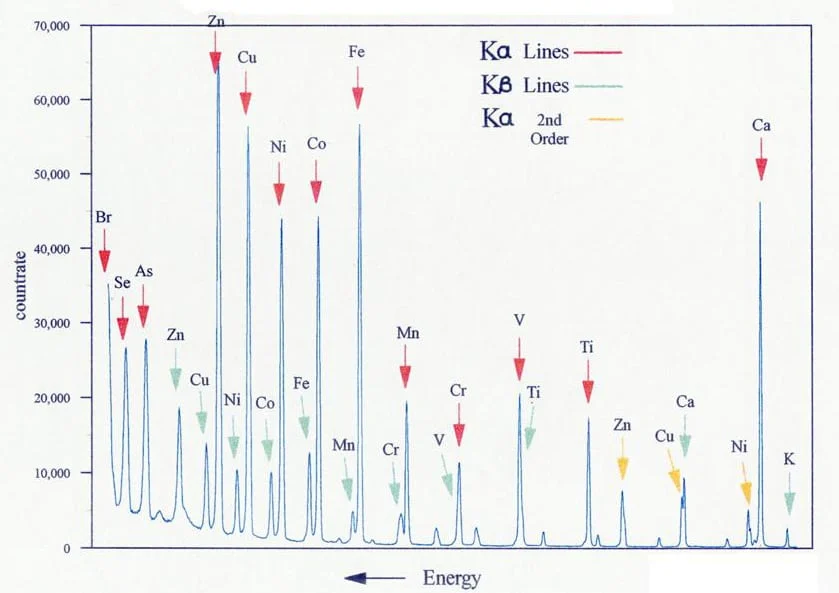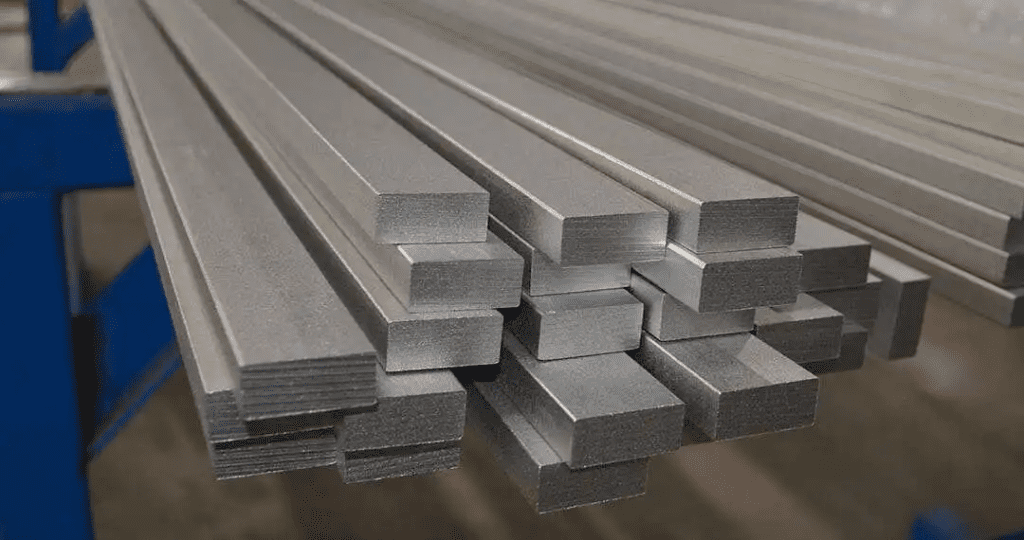X-ray fluorescence (XRF) analysis once was limited to testing geological samples; however, today, it has become an ideal analytical technology for a wide range of applications and industries such as metals, foods, pharmaceuticals, cosmetics, wastes, biofuels, and more. X-ray fluorescence offers an elemental analysis that is fast, efficient, and affordable. Moreover, XRF technology helps these industries ensure the materials they use and produce meet many national and international regulations, such as ASTM, EN, DIN, IEC, and ISO.
However, understanding XRF spectrometry and how it works can be complex. Below, we break it down by describing X-ray technology and how it’s used in X-ray fluorescence spectrometry. We also detail the types and applications of X-ray fluorescence spectrometry to provide you with a better understanding of its value, especially in the metal industry.
What Are X-Rays?
X-rays are produced by the deceleration of high-energy electrons and the transition of electrons in the inner orbital of atoms. The invisible rays travel in a straight line and can be transmitted, reflected, diffracted, and scattered upon striking another matter. Interaction with matter can also produce and emit photoelectrons, auger electrons, spectral lines, and continuum radiation. The X-ray is part of the electromagnetic spectrum, and the range of X-rays used for X-ray fluorescence applications closely matches gamma rays and the high-energy UV range.
Understanding the XRF Spectrometry Working Principle
XRF spectrometers begin their elemental analysis by sending a primary beam of X-rays onto the sample. When the primary beam hits the sample, it excites or ionizes the material. As a result, the atom, which consists of a nucleus (proton + neutron) surrounded by electrons in different orbitals that correspond to different energy levels, inside the material ejects an electron from its inner shell. The innermost shell has the lowest energy level, and the outermost shell has the highest. Thus, it is easier to remove the inner shell electron through small energy radiation.
To fill in the gap left by the removal of the inner shell electron, an outer shell electron drops into the vacant position. This transition results in fluorescence radiation (secondary X-rays) with an energy equivalent to the energy difference between the two electron shells.
Each element in the sample produces x-rays unique to that element, similar to a fingerprint. Thus, analyzing that emitted energy helps you identify the exact element. This is the fundamental idea behind elemental analysis via X-ray fluorescence.

Types of X-Ray Fluorescence Spectrometers
There are two types of XRF spectrometers, energy-dispersive and wavelength-dispersive. Both types are described in more detail below.
Energy-Dispersive X-Ray Fluorescence (EDXRF)
In an energy-dispersive XRF instrument, the fluorescent radiation is collected by a semiconductor detector. Different unique energy signatures received from different materials are sorted and then processed at a high speed in a multi-channel analyzer.
The spectrum is then analyzed to identify the elements present in the sample, making it possible to perform qualitative and quantitative analysis for positive material identification.
Wavelength-Dispersive (WDXRF)
A wavelength-dispersive XRF instrument can be either sequential, simultaneous, or a combination of both for elemental analysis. The sequential WDXRF analyzes only one element at a time, while the simultaneous WDXRF can measure all elements at the same time; however, it requires separate measurement channels for each element to ensure accurate elemental analysis.
Reading XRF Results
Understanding X-ray fluorescence spectrometry results is the key to the correct elemental analysis. The XRF spectrometer displays the number of X-rays counted on the y-axis and the X-ray energy on the x-axis, as shown below.

If the analyzer reads only a few spectrums of a specific element, it indicates a low concentration in the sample and vice versa. An ideal XRF device with high sensitivity and a high count rate ensures high precision and fast measurement of elemental composition.
When it comes to quantification, modern spectrometers can calculate results from several parts per million to one part per million. For quantitative analysis, you have to mix pulverized solids and sample liquid into a pressed pallet or fused bead for testing inside benchtop analyzers. This will take a few more minutes than the handheld device but will produce more accuracy in determining elemental composition. However, correct calibration is necessary to compensate for the matrix effects for high accuracy.
Unique Applications of XRF Analyzers
XRF technology is useful for delivering qualitative data and analyzing different materials, along with their concentrations, present within a sample. The sample for qualitative analysis should be representative of the material to be analyzed and should have the same uniform concentration of elements throughout (homogeneous).
XRF analyzers are available in different sizes, starting from handheld portable guns to high-performance benchtop analyzers. Depending on the type, XRF analyzers can be used in the following industries:
- Glass analysis: XRF technology is used for analyzing raw materials including sand, limestone, dolomite, as well as the finished product.
- Refractory and slag analysis: XRF spectrometers are used for analyzing major oxides and trace elements.
- Vintage paintings: XRF technology can be useful for gaining insight into the distribution of individual pigments in vintage paintings.
- Rocks and minerals analysis: XRF instruments are useful for analyzing most types of rocks, such as granites, granodiorite, basalt, schists, clays, and carbonates, providing both major and trace element analysis.
- Cement and mortar analysis: XRF technology can provide an elementary analysis of raw materials for cement and determine the phase clinker composition.
- Soil sediments and sludges analysis: XRF instruments can provide rapid and potentially accurate soil elemental analyses in contexts of agriculture and pollution.
However, XRF technology is also often used in the metal industry, so understanding how it’s used for verifying the composition of metals is important for fabricators and machinists particularly.
|
Buy Certified High-Quality Metals for Industrial Solutions |
||
|
New Aluminum |
New Steel |
New Stainless Steel |
 |
 |
 |
| Reliable supply: Consistent, certified aluminum stock you can trust. High-quality material: Superior-grade aluminum for precision needs. Custom cuts: Accurate cuts down to thousandths of an inch. |
Durability and strength: Reliable for projects needing long-lasting, tough materials. Cost-effective: Quality steel that offers strength without breaking the bank. Custom cutting: Precise cuts tailored to exact needs with top-tier cutting tools. |
Sustainability: Highly eco-friendly as the most recyclable metal on earth. High durability: Resistant to corrosion and wear, ensuring long-lasting performance. Custom precision cuts: Tailored to your specifications with quick, accurate results. |
The Importance of XRF Spectrometry in the Metal Industry
XRF analyzers support the end-to-end metal production process to ensure accurate quality and composition and to help industries meet regulatory compliances.
If you cannot be assured that the metal you are purchasing meets your required specifications, the entire production process could be jeopardized. However, it is difficult to identify metals solely by their appearances. For instance, aluminum or stainless alloys can look the same, but if not correctly identified with analytical solutions such as elemental analysis, you can have a disastrous outcome. Also, identifying two different alloy grades of the same metal comes with the same challenge. Fortunately, XRF technology can help you easily distinguish between different types and grades of metal alloys, ensuring you have the particular element for your production.
XRF technology is also helpful while analyzing scrap metals for material identification and valuation. Identifying oxidized, coated, or painted scrap metals through their colors can be misleading. A handheld XRF device can easily read the composition of metals within a few seconds to help you separate each by quality.
Detailed Step-by-Step Explanation of XRF Analysis Process
X-ray fluorescence (XRF) spectroscopy is an intriguing and powerful technique for chemical analysis. The process of X-ray fluorescence analysis unfolds in a series of well-defined steps, each essential in understanding the elemental composition of a sample.
Here’s a simplified breakdown:
- X-ray fluorescence begins with the generation of X-rays. These X-rays are directed at the sample, where they interact with the material.
- The X-ray energy causes inner-shell electrons in the sample’s atoms to be ejected, which is a key step in X-ray fluorescence.
- As these vacancies are created, outer-shell electrons move in to fill them. This shift results in the emission of fluorescent X-rays – the heart of X-ray fluorescence.
- These emitted X-rays, characteristic of each element in the sample, are then captured by a detector. This is a crucial part of the ray fluorescence process.
- The detector sends signals to a processor, amplifying and converting them into a form suitable for analysis in X-ray fluorescence.
- The processor, a core component of X-ray fluorescence, analyzes this data, identifying the different elements present in the sample based on their unique X-ray ‘fingerprints.’
- Finally, X-ray fluorescence analysis concludes with the detailed composition of the sample being displayed, providing a comprehensive understanding of its chemical makeup.
This process, known as ray fluorescence analysis, is a non-destructive and highly efficient method for analyzing the elemental composition of various materials, making it a valuable tool in numerous scientific and industrial applications.
Elements Detectable by X-ray Fluorescence Spectrometry
Here’s a concise table showcasing a selection of elements detectable by this analytical technique:
| Element | Atomic Number | Detectable Concentration Range |
| Iron (Fe) | 26 | 0.1% to 100% |
| Copper (Cu) | 29 | 1 ppm to 100% |
| Lead (Pb) | 82 | 10 ppm to 100% |
| Zinc (Zn) | 30 | 1 ppm to 100% |
| Titanium (Ti) | 22 | 0.01% to 100% |
| Gold (Au) | 79 | 1 ppm to 100% |
| Fun fact: Each element in the table above can be precisely identified down to parts per million (ppm), revealing the hidden stories of objects ranging from ancient artifacts to modern industrial materials. |
Purchase Verified Metal Remnants From a Trusted Local Supplier
For more than two decades, Industrial Metal Service has been supplying recycled metal remnants to metal shops and fabricators in the San Francisco Bay Area and beyond for affordable prices. We understand the importance of ensuring the metals you purchase are of the highest quality—that’s why we utilize x-ray fluorescence technology to verify the grade and composition of each metal we recycle.
Our large inventory of recycled metal remnants includes aluminum, titanium, copper, and tungsten carbide. We also offer advanced metal sawing services for high precision and accuracy, saving you time and resources for your machining or fabricating process.
 Angle
Angle Cast Plate
Cast Plate Diamond Plate
Diamond Plate Flat Bar
Flat Bar Plate
Plate Round Bar
Round Bar Square Bar
Square Bar Square Tubing
Square Tubing Round Tubing
Round Tubing Angle
Angle Channel
Channel Diamond Plate
Diamond Plate I Beam
I Beam Round Bar
Round Bar Sheet
Sheet Square tubing
Square tubing Round Tubing
Round Tubing Rectangular Tubing
Rectangular Tubing Plate
Plate Rectangular Bar
Rectangular Bar Rectangular Tubing
Rectangular Tubing Round Bar
Round Bar Sheet
Sheet Square Bar
Square Bar Square Tubing
Square Tubing
